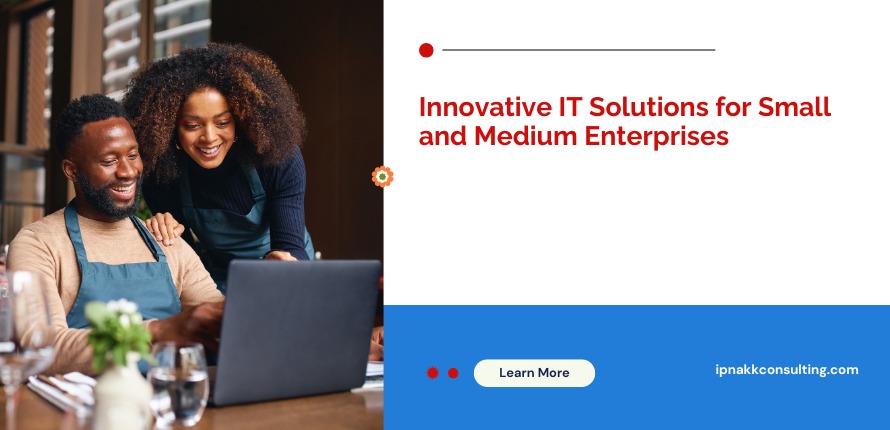Introduction
In the rapidly evolving digital landscape, small and medium enterprises (SMEs) must leverage innovative IT solutions to stay competitive. These solutions not only enhance productivity but also improve customer service and enable significant growth. Despite the challenges SMEs face, adopting the right IT strategies can lead to transformative changes.
Understanding Small and Medium Enterprises (SMEs)
Small and medium enterprises (SMEs) are the backbone of many economies. Defined by their size, revenue, and number of employees, SMEs are characterized by their agility and potential for innovation. They play a crucial role in job creation, economic development, and innovation.
Challenges Faced by SMEs
SMEs often encounter numerous challenges, including financial constraints and limited resources. Unlike larger corporations, SMEs may struggle with access to capital, making it difficult to invest in new technologies. Additionally, they face intense market competition and must continuously adapt to changing market conditions.
The Role of IT in SMEs
Information Technology (IT) plays a pivotal role in the success of SMEs. By enhancing productivity through automation and streamlined processes, IT solutions help SMEs operate more efficiently. Improved customer service is another critical benefit, as IT tools enable better customer relationship management and faster response times. Ultimately, IT solutions can drive significant business growth.
Types of IT Solutions for SMEs
SMEs can benefit from a wide range of IT solutions, including:
- Hardware Solutions: Reliable hardware is essential for daily operations. This includes computers, servers, and networking equipment.
- Software Solutions: Software applications for various business functions, from accounting to project management, are vital.
- Cloud Computing: Cloud services offer flexibility, scalability, and cost savings, making them ideal for SMEs.
Cloud Computing for SMEs
Cloud computing has revolutionized the way SMEs operate. The benefits of cloud computing include:
- Cost Efficiency: Pay-as-you-go models reduce upfront costs.
- Scalability: Easily scale resources up or down based on demand.
- Popular Cloud Services: Services like Amazon Web Services (AWS), Microsoft Azure, and Google Cloud offer robust solutions for SMEs.
Cybersecurity Solutions for SMEs
With increasing cyber threats, cybersecurity is paramount for SMEs. Key aspects include:
- Importance of Cybersecurity: Protects sensitive data and maintains customer trust.
- Types of Cyber Threats: Malware, phishing, and ransomware are common threats.
Best Practices: Implementing firewalls, antivirus software, and regular security audits.
Data Management and Analytics
Effective data management and analytics are critical for informed decision-making. SMEs should focus on:
- Importance of Data: Data drives business insights and strategies.
- Data Management Tools: Tools like Microsoft Power BI and Tableau help manage and visualize data.
- Using Data Analytics: Leveraging data analytics can optimize operations and enhance customer understanding.
Enterprise Resource Planning (ERP) Systems
ERP systems integrate various business processes into a unified system. For SMEs, ERP systems offer:
- Overview: Streamlined operations and real-time data access.
- Benefits: Improved efficiency, reduced costs, and better decision-making.
- Popular ERP Solutions: Solutions like SAP Business One and Oracle NetSuite are tailored for SMEs.
Customer Relationship Management (CRM) Systems
CRM systems are vital for managing customer interactions. Key points include:
- Importance: Enhances customer satisfaction and loyalty.
- Benefits: Centralized customer information, improved communication, and sales tracking.
- Top CRM Tools: Salesforce, HubSpot, and Zoho CRM are popular choices for SMEs.
IT Support and Services
Reliable IT support ensures smooth operations. SMEs should consider:
- Importance of IT Support: Prevents downtime and resolves technical issues quickly.
- Types of IT Services: Managed services, on-demand support, and IT consulting.
- Choosing the Right Provider: Look for providers with experience in your industry and positive reviews.

Digital Marketing Solutions
Digital marketing is essential for reaching and engaging customers online. For SMEs, this includes:
- Importance: Expands reach and builds brand awareness.
- Types of Digital Marketing: SEO, social media marketing, email marketing, and pay-per-click advertising.
- Tools and Platforms: Google Ads, Mailchimp, and Hootsuite offer effective digital marketing solutions.
E-commerce Solutions for SMEs
E-commerce platforms enable SMEs to sell products online. Key considerations include:
- Benefits: Wider customer reach and 24/7 sales opportunities.
- Setting Up an E-commerce Platform: Choose the right platform, set up payment gateways, and optimize for SEO.
- Best E-commerce Platforms: Shopify, WooCommerce, and BigCommerce are popular options for SMEs.
Mobile Solutions for SMEs
Mobile solutions are increasingly important for SMEs. They include:
- Importance: Mobile apps enhance customer engagement and operational efficiency.
- Types of Mobile Solutions: Mobile apps, responsive websites, and mobile payment systems.
- Benefits of Mobile Apps: Increased accessibility, better customer service, and enhanced marketing capabilities.
Remote Work Solutions
The rise of remote work has created new opportunities and challenges for SMEs. Key points include:
- Importance: Offers flexibility and access to a wider talent pool.
- Tools for Remote Work: Collaboration tools like Slack, Zoom, and Trello.
- Managing Remote Teams: Establish clear communication channels and performance metrics.
Innovative Technologies for SMEs
Emerging technologies can provide a competitive edge for SMEs. These include:
- AI and Machine Learning: Automate tasks and gain insights from data.
- IoT: Connect devices for improved efficiency and monitoring.
Blockchain: Enhance security and transparency in transactions.
Cost-Effective IT Solutions
Budgeting for IT is crucial for SMEs. Strategies include:
- Budgeting for IT: Allocate funds for essential IT needs.
- Affordable IT Solutions: Look for cost-effective options that meet business requirements.
- Free and Open-Source Tools: Utilize tools like GIMP for graphic design and LibreOffice for office productivity.
Case Studies of Successful IT Implementation in SMEs
Real-life examples can provide valuable insights. Consider:
- Real-Life Examples: Companies that have successfully implemented IT solutions.
- Lessons Learned: Challenges faced and how they were overcome.
- Best Practices: Strategies for successful IT adoption.
Future Trends in IT for SMEs
Staying ahead of technological trends is vital. Future trends include:
- Emerging Technologies: AI, quantum computing, and 5G.
- Predictions: How these technologies will impact SMEs.
- Preparing for the Future: Steps SMEs can take to stay competitive.
Conclusion
Adopting innovative IT solutions is essential for the growth and success of SMEs. By understanding the various options available and strategically implementing them, SMEs can overcome challenges, enhance productivity, and achieve significant growth. Embracing these technologies is not just a necessity but a pathway to future success.

